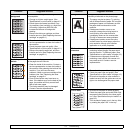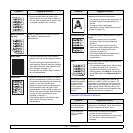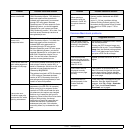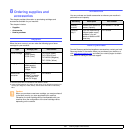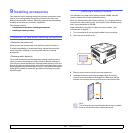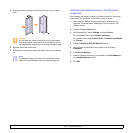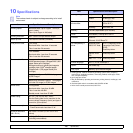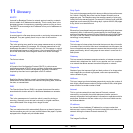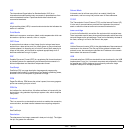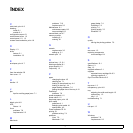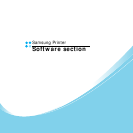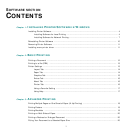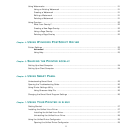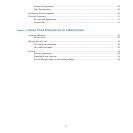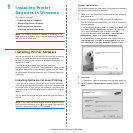
11.1 <
Glossary>
11 Glossary
BOOTP
It stands for Bootstrap Protocol, a network protocol used by a network
client to obtain its IP address automatically. This is usually done in the
bootstrap process of computers or operating systems running on them.
The BOOTP servers assign the IP address from a pool of addresses to
each client.
Control Panel
A control panel is a flat area where control or monitoring instruments are
displayed. They are typically found in top or front of the machine.
Coverage
This is the printing term used for toner usage measurement on printing
and generally used as 5% coverage. 5% coverage means that an A4
sided paper has about 5% image or text on it. So, if the paper or original
has complicated images or lots of text on it, the coverage will be over 5%
and at the same time, toner usage will be as much as the coverage.
Default
The first set values.
DHCP
A Dynamic Host Configuration Protocol (DHCP) is a client-server
networking protocol. A DHCP server provides configuration parameters
specific to the DHCP client host requesting, generally, information
required by the client host to participate on an IP network.
DIMM
Dual Inline Memory Module, a small circuit board that holds memory.
DIMM stores all the data within the machine like printing data, received
fax data, or scanned data.
DNS
The Domain Name Server (DNS) is a system that stores information
associated with domain names in a distributed database on networks.
DPI
This is the measurement of resolution which is used for printing or
scanning. Generally, more dots per inch result in a higher resolution,
more visible detail in the image, and a larger file size.
Duplex
This is a mechanism which automatically flips over a sheet of paper so
that the machine can print (or scan) on both sides of the paper. A printer
equipped with a Duplex can print double-sided.
Duty Cycle
Duty cycle is the page quantity which does not affect printer performance
for a month. Generally the printer has the lifespan limitation such as
pages per year. The lifespan means the average capacity of print-outs,
usually within the warranty period. For example, if the duty cycle is 48,000
pages per month assuming 20 working days, a printer limits 2,400 pages
a day, which is not small amount.
Ethernet
Ethernet is a frame-based computer networking technology for local area
networks (LANs). It defines wiring and signaling for the physical layer,
and frame formats and protocols for the media access control (MAC)/data
link layer of the OSI model. It has become the most widespread LAN
technology in use presently.
Fuser Unit
This is the part of a laser printer that melts the toner onto the print media.
It consists of two hot rollers. After toner is transferred onto the paper, the
fuser unit applies heat and pressure to ensure that the toner stays on the
paper permanently, which is why paper is warm when it comes out of a
laser printer.
Gateway
This is a connection between computer networks, or between a computer
network and a telephone line. And it is very popular, as it is a computer
or a network that allows access to another computer or network.
Grayscale
Shades of gray that represent light and dark portions of an image when
color images are converted to grayscale; colors are represented by
various shades of gray.
Halftone
This is an image type that simulates grayscale by varying the number of
dots. Highly colored areas consist of a large number of dots, while lighter
areas consist of a smaller number of dots.
Intranet
This is a private network that uses Internet Protocols, network
connectivity, and possibly the public telecommunication system to
securely share part of an organization's information or operations with its
employees. Sometimes the term refers only to the most visible service,
the internal website.
IP address
An Internet Protocol address (IP address) is a unique number that
devices use in order to identify and communicate with each other on a
network utilizing the Internet Protocol standard (IP).
IPM
The Images Per Minute.



